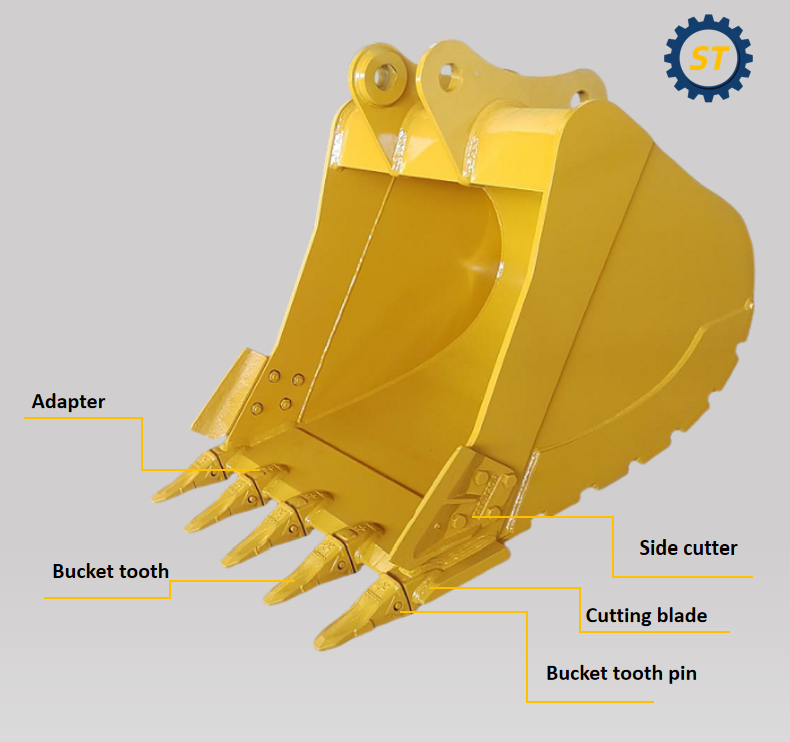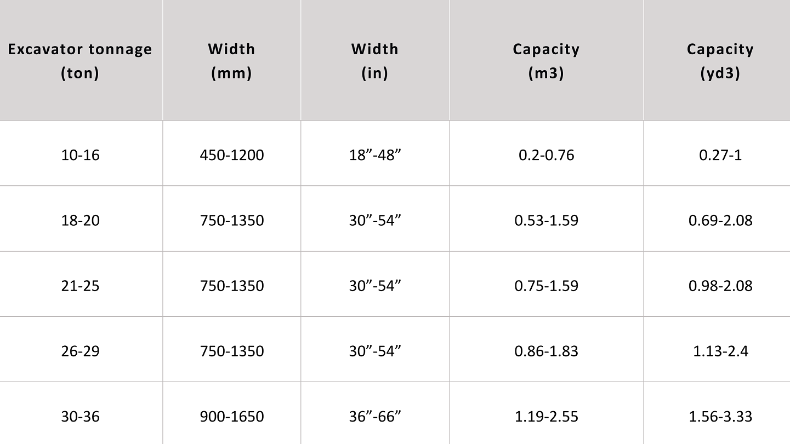Excavator General Purpose Bucket or called Digging Standard Bucket are designed for general duty works such as digging and loading earth, sand, loose rock and gravel etc. Applied to Forestry, Construction, Demolition and Recycling, Land Management, Earthmoving Machinery, Sorting, Rock handling, Civil construction, Material Handling and so on.
• Available in all widths for all excavators.
• Designed and built to be compatible with pin grabbers.
• Built for compatibility and maximum durability.
• Cutting edge, side cutters and side plates designed with high-strength wear plate.
• Bushing, pins, teeth and adapter are hot treated.
• Optional bolt-on side cutters.
• Available for all Quick Coupler types.
• Custom widths, logos, shape, profiles and capacities available.


FAQ
1. Q: How to choose the right bucket capacity based on my excavator's tonnage? What happens if it's too large or too small?
A: It should be based on the excavator's tonnage. Bucket capacity is usually 0.05-0.1 times the excavator's tonnage, or bucket capacity ≈ excavator tonnage × 0.06-0.1. (e.g., 20 ton excavator with 1.2-2.0m³, 30 ton digger with 1.5-3.0m³).
Also based on the working material (e.g., choose 10% larger capacity for sand/clay, 10% smaller for hard rock/construction waste), and operation efficiency requirements. An overly large bucket may cause engine overload, high fuel consumption, and even hydraulic system damage. A too small one reduces efficiency and increases trips.
2. Q: What are the commonly used materials of excavator buckets, and what are their characteristics?
A: ST machinery manufacturing company used materials include manganese steel: Q355 offers good value, suitable for earthwork, clay, light stone work. Wear-resistant steel: NM400/NM450/NM500 for crushing hard rocks. High-strength wear-resistant steel: Hardox400/Hardox450/Hardox500, extremely wear-resistant, suitable for mines and quarries.
3. Q: For the same tonnage excavator, should I choose a reinforced or standard bucket? What working conditions are they suitable for?
A: Reinforced buckets (thickened body with reinforcing ribs) are suitable for heavy-load operations like hard rock and construction waste, with a service life over 50% longer than standard ones; standard buckets are for light work like earthwork and sand, offering higher cost-effectiveness, lighter weight, and lower fuel consumption.
4. Q: The construction site needs to handle earthwork, crushing, and grabbing operations - Buying multiple attachments is too costly. Is there a cost-effective solution?
A: Choose a "quick coupler + universal attachment" combination. A quick coupler allows switching between breaker, grapple, and bucket within 3 minutes without frequent disassembly of hydraulic pipelines; prioritize universal attachments suitable for multiple conditions (e.g., multi-functional grapple for both wood grabbing and light crushing) to reduce equipment procurement costs.
5. Q: The bucket has cracks or deformation - Can it still be used? Is repairing or replacing it more cost-effective?
A: Minor cracks (length <5cm) can be repaired by grinding and surfacing with wear-resistant electrodes, suitable for small and medium-tonnage buckets; overlong cracks (>10cm) or structural deformation (e.g., bucket body distortion) require replacement to avoid breakage and safety accidents. If repair cost exceeds 30% of a new bucket, replacement is better (new buckets usually last 2-3 times longer than repaired ones).
6. Q: When the bucket edge and teeth are worn, is it better to replace them entirely or repair?
A: If the edge wear is less than 1/3 of its original thickness, surfacing with wear-resistant welding wire is more cost-effective; for bucket teeth, replacing only the tips (saves 50% vs. replacing the whole set) works if only the tips are worn. If the edge is severely deformed or tooth seats are broken, replacing with new ones is better to avoid short service life and efficiency loss after repair.
7. Q: How long does an excavator bucket last, and what signs indicate it must be replaced?
A: The normal service life is usually 1000-3000 hours (depending on material and working conditions). Signs that replacement is necessary: The bucket body is severely deformed, reducing loading capacity by over 30%; the cutting edge is worn to less than 1/3 of its original thickness; cracks longer than 10cm appear and reoccur even after repair.
8. Q: How to judge if excavator attachments need maintenance? What are the key points of daily maintenance?
A: Maintenance is needed immediately when there is stuck movement, abnormal noise, or oil leakage. Daily maintenance: ① Clean soil on the attachment surface after each operation, check pin lubrication (add grease weekly); ② Inspect hydraulic pipe joints monthly for tightness and replace aging seals; ③ For breakers, regularly check drill rod wear; for grapples, check claw tightness to avoid falling during operation.
Please contact us for more details to meet your application needs.